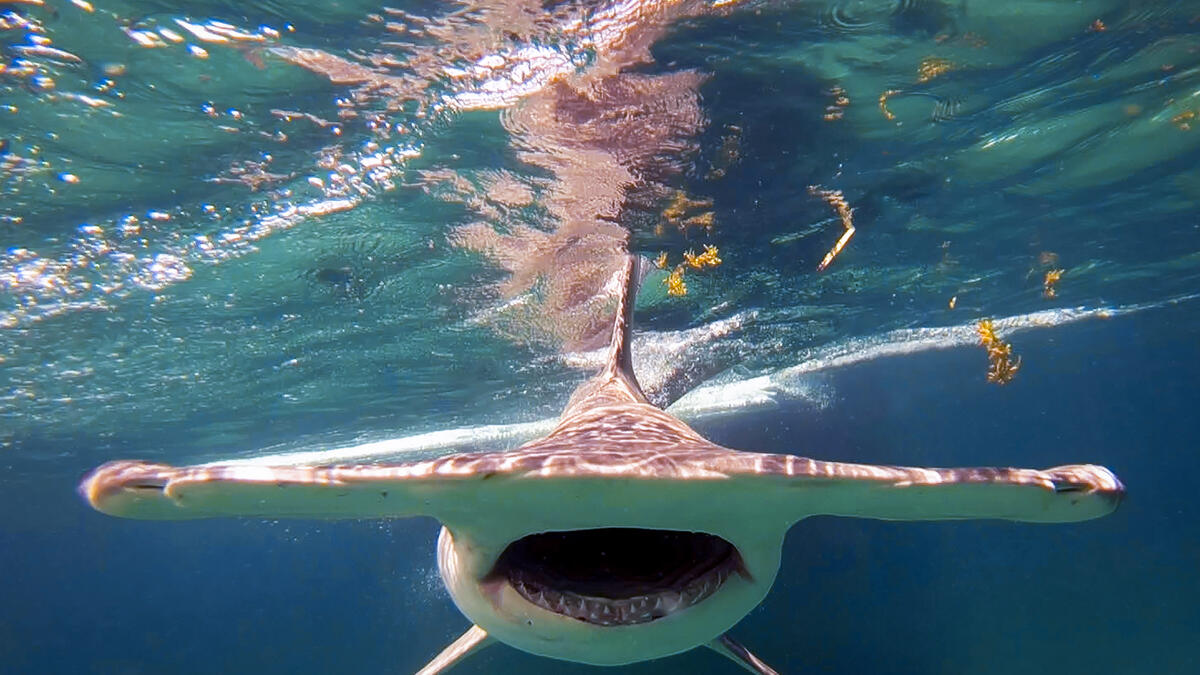How media mistakes threaten global shark survival

A great hammerhead shark Sphyrna lewini swims away after a research workup. These iconic sharks received more conservation-relevant media attention over the past decade than any other species of shark, according to an ASU analysis of how shark conservation media is portrayed in the global popular press. Photo credit: Jacob Jerome, Field School, used with permission.
Sharks are among the most threatened animals in the world, and more people than ever now want to help. But a deep analysis of news coverage of shark conservation issues over 10 years reveals an alarming pattern of inaccurate reporting. This misinformation results in broad misunderstandings of the true issues among both media consumers and policymakers.
David Shiffman, a marine conservation biologist at Arizona State University's New College of Interdisciplinary Arts and Sciences, led a team that analyzed nearly 2,000 media articles dating back to 2008. The analysis reveals that worldwide media coverage of shark conservation topics is biased and inaccurate, omitting or misrepresenting key facts and not reporting on expert-backed solutions that have scientific data demonstrating their effectiveness.
“Sharks face many threats, and there are many available policy solutions to address those threats. However, you wouldn’t know that from reading newspaper coverage of this important and complex issue,” Shiffman said.
Examples of media misinformation include an overemphasis of threats, such as the shark fin trade verses the shark meat trade, which is a major and growing threat that’s less well understood. This skew in coverage has led in part to shark fin trade bans despite no evidence that these trade bans actually help sharks. The research notes that shark finning has been illegal in the United States since the 1990s, an important point that is often confused in media coverage of these issues.
Media coverage also dramatically under-reports on truly endangered shark species in favor of well-known species, such as great white sharks. Critically endangered species of sharks were mentioned only 20 times in nearly 2,000 articles.
“Our analysis reveals major issues with factual inaccuracy, bias and omission of key facts in the last decade of media coverage of shark conservation — and that means that many people who want to help don’t really understand the problem or which solutions are most effective to solve the problem,” Shiffman said.
Shiffman’s research paper, “Inaccurate and biased global media coverage underlies public misunderstanding of shark conservation threats and solutions,” is now published in the open access journal iScience, which focuses on interdisciplinary scientific research. The paper also includes an extensive introduction to scientific facts about shark conservation, written explicitly for nonexpert audiences and journalists wishing to more thoroughly understand this issue.
More Science and technology

Cracking the code of online computer science clubs
Experts believe that involvement in college clubs and organizations increases student retention and helps learners build valuable…
Consortium for Science, Policy & Outcomes celebrates 25 years
For Arizona State University's Consortium for Science, Policy & Outcomes (CSPO), recognizing the past is just as important as…

Hacking satellites to fix our oceans and shoot for the stars
By Preesha KumarFrom memory foam mattresses to the camera and GPS navigation on our phones, technology that was developed for…